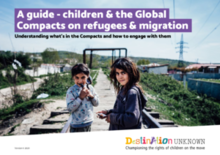This guide analyses the Global Compact for Safe, Orderly and Regular Migration (GCM) and the Global Compact on Refugees (GCR) through a child rights lens and outlines the measures foreseen in these documents (the Global Compacts) for the protection of the rights of the child.
Although the Global Compacts are not legally binding, they have significant implications for everyone involved. Recognising the principle of State sovereignty, both compacts provide important guidance on measures to be undertaken for the benefit of refugees, migrants and the communities of host and destination countries. The Global Compacts are based on and reflect international law, including the United Nations (UN) Charter, refugee law and international human rights law. They both strongly build upon the Convention on the Rights of the Child (CRC) and, if properly implemented, would significantly improve the protection of the rights of children on the move and other children in the context of migration.
Most of the measures foreseen by the Global Compacts have been implemented somewhere already. Many measures reflect existing good practices implemented by States and in many cases, there is consensus among the international community that replicating and scaling them up would strengthen responses to refugee and migration situations.
The COVID-19 pandemic has highlighted the urgent need for change and the Global Compacts remain relevant frameworks for addressing and mitigating the challenges that the pandemic brought for everyone, including refugees and migrants.

